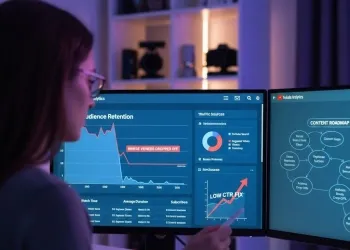Examining the vertical GPU mount performance debate vs. graphics card aesthetics. Learn how case airflow dynamics, riser cable quality, and thermal throttling are impacted.
The trend of using a vertical GPU mount has exploded in the PC building community, driven almost entirely by graphics card aesthetics. As GPUs have grown larger and incorporated increasingly elaborate shrouds, cooling fans, and RGB lighting, builders naturally want to showcase the central component of their rig. However, this aesthetic choice introduces a significant performance debate rooted in physics and case design, often leading to compromises in case airflow dynamics and the potential for thermal throttling.
Aesthetics: Making the GPU the Centerpiece
The primary motivation for the vertical GPU mount is visual. The traditional horizontal mounting position means the GPU cooler—often a piece of industrial design art with complex lines and lighting—faces downward toward the floor of the case, largely obscured from view through a glass side panel. The visible part is the narrow side edge, which may only feature a simple logo.
Showcasing Premium Hardware
By rotating the card 90 degrees, the entire face of the graphics card aesthetics is visible through the side panel. This is particularly appealing for:
- Triple-Fan Designs: Highlighting large, custom coolers and their unique fan blade designs.
- RGB Integration: Maximizing the visibility of integrated lighting, turning the GPU into the centerpiece of the build's lighting scheme.
- Watercooling: For custom loop builders, a vertical GPU mount is essential for showing off a custom water block and the flow of the coolant.
Eliminating GPU Sag
While an aesthetic choice, a functional benefit of the vertical GPU mount is that it naturally eliminates GPU sag. Modern, heavy graphics cards can exert significant downward leverage on the motherboard's PCIe slot. Vertical mounting distributes the card’s weight differently, often relying on a sturdy metal bracket that supports the card's full width, removing the need for separate GPU support brackets.
The Airflow and Thermal Performance Debate
The central issue in the performance debate is the physical proximity of the vertically mounted GPU to the case’s side panel, which is typically tempered glass.
Restricting Air Intake: The Proximity Problem
In most standard PC cases, a vertically mounted GPU sits much closer to the side panel than when mounted horizontally. The GPU's open-air cooling fans, which are designed to intake cool air from below and push it through the fin stack, now face the glass. This minimal clearance starves the fans of necessary fresh air, leading to a phenomenon known as "choking."
- Reduced Clearance: If the gap between the GPU fans and the glass is less than 20-30mm (about 1 inch), the fans must work harder and spin faster to pull air, resulting in higher noise and less efficient cooling.
- Hot Air Recirculation: The hot air the card does manage to exhaust can be immediately drawn back into the fans, raising the intake temperature and accelerating thermal throttling.
Disrupting Case Airflow Dynamics
The placement of a large, thick GPU vertically can act as a literal wall, dramatically altering the planned case airflow dynamics. Most cases are designed for a front-to-back or bottom-to-top airflow path.
- Blocking Intake: A vertical card can block the flow of fresh air coming from the front intake fans toward the CPU and other motherboard components (like the VRMs and M.2 SSDs).
- Heatpipe Orientation: Some GPU coolers utilize internal heat pipes that are optimized for gravity in a horizontal orientation. Mounting the card vertically can sometimes hinder the efficient return (reflux) of the cooling liquid, slightly impacting efficiency.
The result of these thermal challenges is often an increase in GPU core temperatures, typically ranging from 3 degrees Celsius to 10 degrees Celsius or more under load. This temperature hike can push the GPU past its ideal temperature range, triggering thermal throttling, where the card automatically reduces its clock speeds to protect itself, causing a noticeable drop in gaming or application performance.
The Technical Compromises: Riser Cable Quality
The use of a vertical GPU mount necessitates an extension cable, known as a riser cable, to connect the GPU's PCIe slot to the motherboard's slot.
PCIe Performance Degradation
The riser cable quality is a crucial element in the performance debate. A riser cable adds an intermediary layer between the GPU and the motherboard, increasing the potential for signal integrity issues and electromagnetic interference (EMI).
- PCIe 4.0 and 5.0 Requirements: With modern GPUs utilizing the high bandwidth of PCIe 4.0 (up to 64GB/s) and now PCIe 5.0, low-quality or poorly shielded riser cables can struggle to maintain the required signal quality. This can force the connection to drop down to a slower standard (e.g., PCIe 3.0), resulting in a slight, but measurable, performance degradation, especially in bandwidth-intensive workloads.
- Pre-configuration: It is often necessary to manually set the motherboard's BIOS to the correct PCIe generation (e.g., Gen4) before installation, as auto-detection can sometimes fail with a riser cable, leading to frustrating boot issues.
The Solution: Premium Riser Cable Quality
To mitigate the risk of performance loss, builders must invest in high-quality, EMI-shielded riser cable quality kits that are explicitly rated and tested for PCIe 4.0 (or 5.0, depending on the system). These premium cables minimize signal loss and ensure the GPU operates at its full intended bandwidth, largely resolving the technical compromise for most users.
Systematic Optimization Strategies
Achieving the desired graphics card aesthetics without sacrificing performance requires careful planning and optimization.
Choosing the Right Case and Mount
The success of a vertical GPU mount depends heavily on the case design:
- Wide Cases: Cases explicitly designed for vertical mounting (like certain Lian Li or Corsair models) offer ample clearance (ideally 30mm or more) between the GPU fans and the side glass panel.
- Aftermarket Kits: Premium aftermarket vertical GPU mount kits (e.g., from CableMod or Cooler Master) often position the card farther away from the side panel than the case's built-in vertical slots.
- Mesh Panels: In Small Form Factor (SFF) or specialty cases, replacing the glass side panel with a mesh or vented panel allows the vertically mounted GPU to draw in fresh external air, often leading to better temperatures than a horizontal mount.
Fan Configuration for Vertical Airflow
To support the vertical card, case airflow dynamics must be re-optimized:
- Bottom Intake: The most critical adjustment is installing powerful intake fans at the bottom of the case, directly blowing cool air up toward the vertical GPU's fans.
- Top/Rear Exhaust: Maximizing top and rear exhaust ensures the hot air expelled by the GPU is quickly drawn out of the chassis, preventing heat soak and reducing the risk of thermal throttling.



































